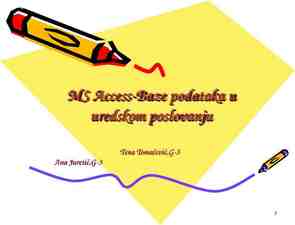areaDetector: A module for EPICS area detector support Mark
59 Slides3.92 MB

areaDetector: A module for EPICS area detector support Mark Rivers GeoSoilEnviroCARS, Advanced Photon Source University of Chicago

areaDetector Talk Outline Aimed at beamline scientists, not programmers or beamline controls staff. Motivation & goals for areaDetector module Overview of architecture Drivers for detectors & cameras Plugins for real-time processing Viewers and other clients Break Demo with simDetector and Point Grey USB-3 camera

areaDetector - Goals Drivers for many detectors popular at synchrotron beamlines – Handle detectors ranging from 500 frames/second to 1 frame/second Basic parameters for all detectors – E.g. exposure time, start acquisition, etc. – Allows generic clients to be used for many applications Easy to implement new detector – Single device-driver C file to write. EPICS independent. Easy to implement detector-specific features – Driver understands additional parameters beyond those in the basic set Middle-level plug-ins to add capability like regions-of-interest calculation, file saving, etc. – Device independent, work with all drivers – Below the EPICS layer for highest performance

areaDetector – Data structures NDArray – N-Dimensional array. Everything is done in N-dimensions (up to 10), rather than 2. This is needed even for 2-D detectors to support color. Other types of devices (Xspress3 and xMAP x-ray spectrometers, quad electrometers also use NDArrays and areaDetector plugins. – This is what plug-ins callbacks receive from device drivers. NDAttribute – Each NDArray has a list of associated attributes (metadata) that travel with the array through the processing pileline. Attributes can come from driver parameters, any EPICS PV, or any user-written function. Can store motor positions, temperature, ring current, amplifier gains, etc. with each frame. Written to disk files for TIFF, netCDF, and HDF5 file formats. NDArrayPool – Allocates NDArray objects from a freelist – Plugins access in readonly mode, increment reference count – Eliminates need to copy data when sending it to callbacks.

Layer 6 EPICS CA clients Layer 5 Standard EPICS records EPICS areaDetector Architecture Channel Access Clients (CSS, medm, Python, ImageJ, SPEC, etc.) ADBase .template Layer 4 EPICS device support Layer 3 Plug-ins Layer 2 Device drivers Layer 1 Hardware API xxxDriver .template NDPluginBas e .template NDPluginXXX . template C Base classes (NDArray, asynPortDriver, asynNDArrayDrive r, ADDriver, NDPluginDriver) Standard asyn device support (device-independent) StdArrays Process ROI File (HDF5, netCDF, TIFF, JPEG) Driver Channel access Vendor API Hardware Record/device support asynInt32, Float64, Octet asynXXXArray asynGenericPointer (NDArray) C library calls

Detector Drivers Currently 33 detector drivers covering a wide variety of detectors. Simulation driver GigE cameras (Prosilica/AVT, Point Grey/FLIR, any GigEVision camera via aravis library) Point Grey USB-3.x cameras Dectris Pilatus and Eiger pixel array detectors Princeton Instruments and Photometrics detectors and spectrometers Andor CCD and CMOS cameras Perkin Elmer and Dexela flat panel detectors Web cameras and Axis video servers Many more (Bruker, Pixirad, Photonic Sciences, etc.)

ADBase.adl – Generic control screen Works with any detector Normally write custom control for each detector type to hide unimplemented features and expose driver-specific features

simDetector: Detector-specific screen Example 1024x1024 pixels 16-bit integer images 485 frames/s 1GB/s

simDetector Driver 3 simulation modes, LinearRamp, Peaks, Sine Waves. Independent gains for X, Y, Overall, Red, Green, Blue Linear ramp has X and Y linear ramp with array index, each cycle just adds value to each pixel. Very fast. Peak mode is array of Gaussian peaks plus noise. Slower. Sine mode is 2 sine waves in each of Y and Y, summed or multiplied. Slower.

simDetector: Linear Ramp Mode

simDetector Peaks mode with FFT

simDetector: Sine mode

Pilatus specific control screen

LightField driver

LightField driver

URL Driver Driver that can read images from any URL. Can be used with Web cameras and Axis video servers. Uses GraphicsMagick to read the images, and can thus handle a large number of image formats (JPEG, TIFF, PNG, etc.).

Perkin Elmer Flat Panel Driver

Point Grey drivers Driver for all cameras from Point Grey using their FlyCap2 SDK. GigE, USB 3.0, and 10 GigE camera High performance, low cost I will demonstrate USB-3.0 camera today Recently wrote new ADSpinnaker driver which uses their new Spinnaker SDK. Required for their newest camera models like BlackFlyS and Oryx 10-GBit Ethernet.

Point Grey GigE Camera BlackFly PGE-20E4C - e2v EV76C570 CMOS sensor Global shutter 29 x 29 x 30 mm Power Over Ethernet 4.5 micron pixels 1600 x 1200 pixels, color or mono) 50 frames/s 525 - 5X cheaper than comparable Prosilica cameras we bought in the past

Point Grey USB-3.0 Camera Grasshopper3 GS3-U3-23S6M 1920 x 1200 global shutter CMOS Sony IMX174 1/1.2 Dynamic range of 73 dB Peak QE of 76% Read noise of 7e12-bit or 8-bit data Max frame rate of 162 fps – 356 MB/S, 3X faster than GigE USB 3.0 interface Now used for tomography at 3 APS beamlines, replaced Andor Neo and PCO Edge 995

Point Grey 10-Gbit Ethernet Camera Oryx ORX-10G-51S5C-C 2448 x 2048 global shutter CMOS Sony IMX250 2/3” Dynamic range of 72 dB Peak QE of 62% Read noise of 2.2e12-bit, 10-bit, or 8-bit data Max frame rate of 162 fps – 779 MB/S, 8X faster than GigE 1,875

Point Grey Driver

Point Grey Driver (Grasshopper3 camera)

Plugins Designed to perform real-time processing of data, running in the EPICS IOC (not over EPICS Channel Access) Receive NDArray data over callbacks from drivers or other plugins Plug-ins can execute in their own threads (non-blocking) or in callback thread (blocking) – If non-blocking then NDArray data is queued – If executing in callback thread, no queuing, but slows driver Allows – Enabling/disabling – Throttling rate (no more than 0.5 seconds, etc) – Changing data source for NDArray callbacks to another driver or plugin Plugins can be sources of NDArray callbacks, as well as consumers – Allows creating a data processing pipeline running at very high speed, each in a different thread, and hence in multiple cores on modern CPUs.

NDPluginDriver medm Screens

Plugins (continued) Currently 20 plugins that perform wide variety of operations NDPlugInStdArrays – Receives arrays (images) from device drivers, converts to standard arrays, e.g. waveform records. – This plugin is what EPICS channel access viewers normally talk to. NDPluginPVA – – – – Converts NDArrays to EPICS V4 NTNDArrays Exports the NtNDArrays over PVAccess with internal V4 server Can be used to send structured data to EPICS V4 clients When used with the PVAccess driver then areaDetector plugins can be run on different machine from the detector driver NDPluginROI – Performs region-of-interest calculations – Select a subregion. Optionally bin, reverse in either direction, convert data type. – Divide the array by a scale factor, which is useful for avoiding overflow when binning. NDPluginTransform – Performs geometric operations (rotate, mirror in X or Y, etc.)

Plugins (continued) NDPluginStats – Calculates basic statistics on an array (min, max, sigma) – Optionally computes centroid centroid position, width and tilt. – Optionally Computes X and Y profiles, including average profiles, profiles at the centroid position, and profiles at a user-defined cursor position. – Optionally computes the image histogram and entropy NDPluginROIStat – Multiple ROIs with simple statistics in a single plugin – More efficient when many ROIs are needed, e.g. for peaks in a 1-D energy spectrum – Min, max, total, net, mean – Time-series of each of these statistics

Plugins (continued) NDPluginProcess – – – – – – – Does arithmetic processing on arrays Background subtraction. Flat field normalization. Offset and scale. Low and high clipping. Recursive filtering in the time domain. Conversion to a different output data type. NDPluginOverlay – Adds graphic overlays to an image. – Can be used to display ROIs, multiple cursors, user-defined boxes, text, etc. ffmpegServer – MJPEG server that allows viewing images in a Web browser. From DLS.

Plugins (continued) NDPluginAttribute – Extracts NDAttributes from NDArrays and publishes their values as ai records – Can collect time-series arrays of the attribute values NDPluginCircularBuff – – – – Buffers NDArrays in a circular buffer Computes a trigger expression using up to 2 NDAttribute values When trigger condition is met then outputs NDArrays User-specified number of pre-trigger and post-trigger arrays to output NDPluginTimeSeries – Accepts 1-D NDArrays[NumSignals] or 2-D [NumSignals,NewTimePoints] and appends to time-series buffer – Operates in fixed length (stop when full) or circular buffer modes – Optional time-averaging of input data

Plugins (continued) NDPluginFFT – Computes FFT of 1-D or 2-D NDArrays – Exports NDArrays containing the absolute value (power spectrum) of the FFT – Exports 1-D arrays of the FFT real, imaginary, absolute values, and time and frequency data. NDPluginColorConvert – Convert from one color model to another (Mono, RGB1 (pixel), RGB2 (row) or RGB3 (planar) interleave) – Bayer conversion removed from this plugin, now part of Prosilica and Point Grey drivers.

commonPlugins.adl All plugins at a glance

ROI plugin

Statistics plugin

Statistics plugin (continued)

Overlay plugin Centroid of laser pointer calculated by statistics plugin Cursor overlay X, Y position linked to centroid

Processing plugin

Processing plugin 30 microsec exposure time No filtering N 100 recursive average filter

Transform plugin

NDPluginPva (EPICS V4/7) New plugin that converts NDArrays into the EPICS v4 normative type NTNDArray Embedded EPICSv4 server serves the new NTNDArray structure as an EPICSv4 PV High performance, 3.2GB/s shown here Can be received by any EPICS v4 client – – – – Java, Python, C versions of pvAccess CSS has a widget that can display NTNDArrays New ImageJ plugin Can include an NTNDArray receiver in another IOC From Bruno Martins

pvAccess Driver (EPICS V4) Logical inverse of NDPluginPva Receives NTNDArrays over the network, converts to NDArrays and calls plugins Can be used to run areaDetector IOC and plugins on another machine or in another process High performance: – 1.2 GB/s shown here with interprocess communication – Saturating 10 Gb Ethernet links has been demonstrated From Bruno Martins

Plugins: NDPluginFile Saves NDArrays to disk 3 modes: – Single array per disk file – Capture N arrays in memory, write to disk either multiple files or as a single large file (for file formats that support this.) – Stream arrays to a single large disk file For file formats that support it, stores not just NDArray data but also NDAttributes

Plugins: NDPluginFile File formats currently supported – NDFileTIFF Supports any NDArray data type Stores NDAttributes as ASCII user tags – NDFileJPEG With compression control – NDFileNetCDF Popular self-describing binary format, supported by Unidata at UCAR – NDFileHDF5 Writes HDF5 files with the native HDF5 API, unlike the NeXus plugin which uses the NeXus API. Supports 3 types of compression. Supports using an XML file to define the layout and placement of NDArrays and NDAttributes in the HDF5 file Support Single Writer Multiple Reader (SWMR). Only supported on local file systems, GPFS, and Lustre (not NFS or SMB)

Plugins: NDPluginFile File formats currently supported – NDFileNeXus Standard file format for neutron and x-ray communities, based on HDF5, which is another popular self-describing binary format; richer than netCDF May be deprecated in a future release since NeXus files can now be produced with the NDFileHDF5 plugin using an appropriate XML layout file – NDFileMagick Uses GraphicsMagick to write files, and can write in dozens of file formats, including JPEG, TIFF, PNG, PDF, etc. – NDFileNull Used only to delete original driver files when no other file plugin is running

File saving with driver In addition to file saving plugins, many vendor libraries also support saving files (e.g. marCCD, mar345, Pilatus, etc.) and this is supported at the driver level. File saving plugin can be used instead of or in addition to vendor file saving – Can add additional metadata vendor does not support – Could write JPEGS for Web display every minute, etc.

NDPluginFile display: TIFF Example: saving 82 frames/second of 1024x1024 video to TIFF files, a few dropped frames.

NDFileHDF5

NDFileHDF5 XML file to define file layout xml group name "entry" attribute name "NX class" source "constant" value "NXentry" type "string" /attribute group name "instrument" attribute name "NX class" source "constant" value "NXinstrument" type "string" /attribute group name "detector" attribute name "NX class" source "constant" value "NXdetector" type "string" /attribute dataset name "data" source "detector" det default "true" attribute name "NX class" source "constant" value "SDS" type "string" /attribute attribute name "signal" source "constant" value "1" type "int" /attribute attribute name "target" source "constant" value "/entry/instrument/detector/data" type "string" /attribute /dataset group name "NDAttributes" attribute name "NX class" source "constant" value "NXcollection" type "string" /attribute dataset name "ColorMode" source "ndattribute" ndattribute "ColorMode" /dataset /group !-- end group NDAttribute -- /group !-- end group detector -- group name "NDAttributes" ndattr default "true" attribute name "NX class" source "constant" value "NXcollection" type "string" /attribute /group !-- end group NDAttribute (default) -- group name "performance" dataset name "timestamp" source "ndattribute" /dataset /group !-- end group performance -- /group !-- end group instrument -- group name "data" attribute name "NX class" source "constant" value "NXdata" type "string" /attribute hardlink name "data" target "/entry/instrument/detector/data" /hardlink !-- The "target" attribute in /entry/instrument/detector/data is used to tell Nexus utilities that this is a hardlink -- /group !-- end group data -- /group !-- end group entry -- /xml

Multiple Threads per Plugin Support for multiple threads running the processCallbacks() function in a single plugin. Can improve the performance of the plugin by a large factor. Linear scaling with up to 5 threads (the largest value tested) observed for most of the plugins that now support multiple threads. Maximum number of threads that can be used for the plugin is set in constructor and in IOC startup script. Actual number of threads to use controlled via an EPICS PV at run time, up to the maximum value. Optional sorting of NDArrays by uniqueId to attempt to output them in the correct order. Several new parameters to control this option Plugins needed minor modifications to be thread-safe for multiple threads running in a single plugin object. Most compute-intensive plugins now support multiple threads.

Multiple Threads per Plugin 1 Thread

Multiple Threads per Plugin 3 Threads

Multiple Threads per Plugin 5 Threads

NDPluginScatter Used to distribute (scatter) the processing of NDArrays to multiple downstream plugins Allows multiple instances of a plugin to process NDArrays in parallel, utilizing multiple cores to increase throughput. Utilizes modified round-robin for choosing next output plugin More complex than multiple threads in a single plugin, but allows the plugins running in parallel to have different configurations or even be different plugins NDPluginGather Merges NDArrays from multiple upstream plugins into a single output stream. Designed to work with NDPluginScatter Optional sorting by uniqueId

Distributed Processing with NDPluginScatter EPICS V4 Distribute HDF5 file writing to multiple IOCs (4096 x 3078 8-bit) IOC #1 ADSimDetector IOC #2 IOC #3 NDPluginScatter IOC #4 NDPluginPva NDPluginPva NDPluginPva pvaDriver pvaDriver pvaDriver NDFileHDF5 NDFileHDF5 NDFileHDF5 # IOCs 1 2 3 Files/sec 101.0 195.2 217.5 GB/sec 1.19 2.29 2.55

Viewers areaDetector allows generic viewers to be written that receive images as EPICS waveform records over Channel Access Current viewers include: – ImageJ plugin EPICS AD Display. ImageJ is a very popular image analysis program, written in Java, derived from NIH Image. – EPICS NTNDA Viewer. Same as above but uses pvAccess rather than Channel Access. – ffmpegServer allows image display in any Web browser – ffmpegViewer high-performance Qt-based viewer for MJPEG stream

EPICS NTNDA Viewer ImageJ plugin New ImageJ plugin written by Tim Madden and Marty Kraimer Essentially identical to EPICS AD Viewer.java except that it displays NTNDArrays from the NDPluginPva plugin, i.e. using pvAccess to transport the images rather than NDPluginStdArrays which uses Channel Access.

NDPluginPva Advantages NTNDArray data transmitted "atomically" over the network – Channel Access requires separate PVs for the image data and the metadata (image dimensions, color mode, etc.) With Channel Access data type of waveform record is fixed at iocInit, cannot be changed at runtime. – If the user wants to view both 8-bit images, 16-bit images, and 64-bit double FFT images then waveform record needs to be 64-bit double, adding a factor of 8 network overhead when viewing 8-bit images. – pvAccess changes the data type of the NTNDArrays dynamically at run-time, removing this restriction. Channel Access requires setting EPICS CA MAX ARRAY BYTES – Source of considerable confusion and frustration for users. – pvAccess does not use EPICS CA MAX ARRAY BYTES and there is no restriction on the size of the NTNDArrays.

Viewers EPICS AD Controller. Allows using the ImageJ ROI tools (rectangle and oval) to graphically define the following: The readout region of the detector/camera The position and size of an ROI (NDPluginROI) The position and size of an overlay (NDPluginOverlay) The plugin chain can include an NDPluginTransform plugin which changes the image orientation and an NDPluginROI plugin that changes the binning, size, and X/Y axes directions. The plugin corrects for these transformations when defining the target object. – Chris Roehrig wrote an earlier version of this plugin. – – – –

Other Drivers that use ADCore NDArrays are not limited to 2-D detectors – File, ROI, and statistics plugs are useful for other types of detectors Used for spectra arrays [NumMCAChannels, NumDetectors, NumPixels] for: – Xspress3 from Quantum Detectors – xMAP, Mercury and new FalconX from XIA Used for time-series data [NumTimePoints, NumInputs] for the quadEM quad electrometer software – AH401, AH501, TetrAMM from CaenEls – Two types of electrometers from BNL Instrumentation group (Peter Siddons)

Conclusions Architecture works well, easily extended to new detector drivers, new plugins and new clients Base classes, asynPortDriver, asynNDArrayDriver, asynPluginDriver actually are generic, nothing “areaDetector” specific about them. They can be used to implement any N-dimension detector, e.g. the XIA xMAP (16 detectors x 2048 channels x 512 points in a scan line) Can get documentation and pre-built binaries (Windows) from our Web site: – http://cars.uchicago.edu/software/epics/areaDetector Can get code from github – https://github.com/areaDetector






